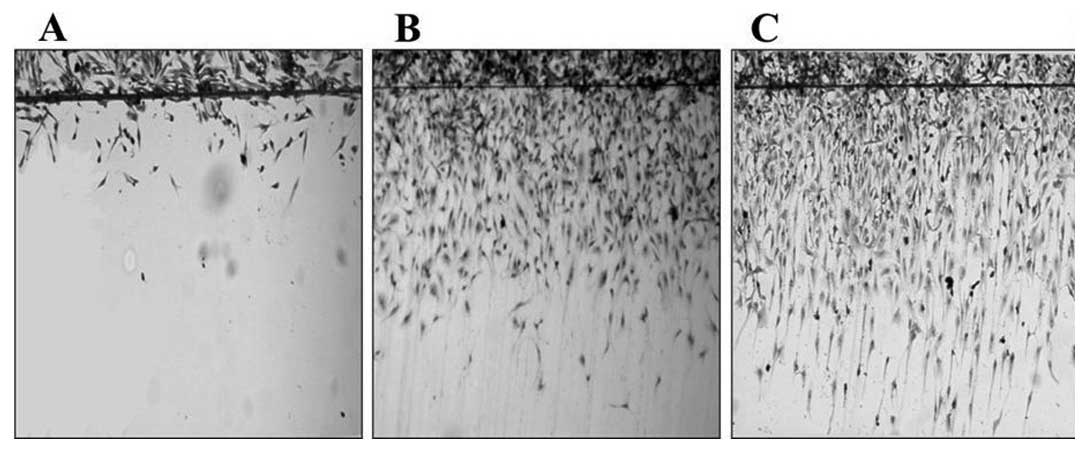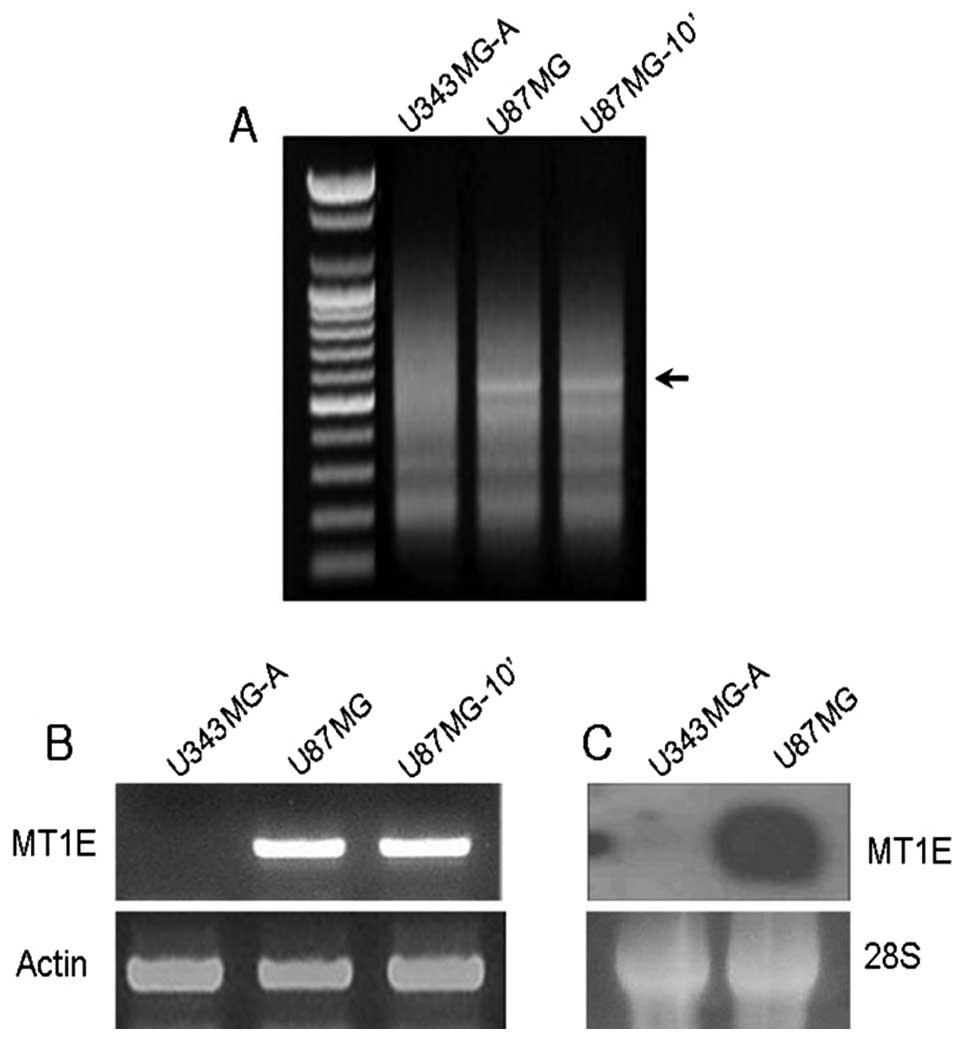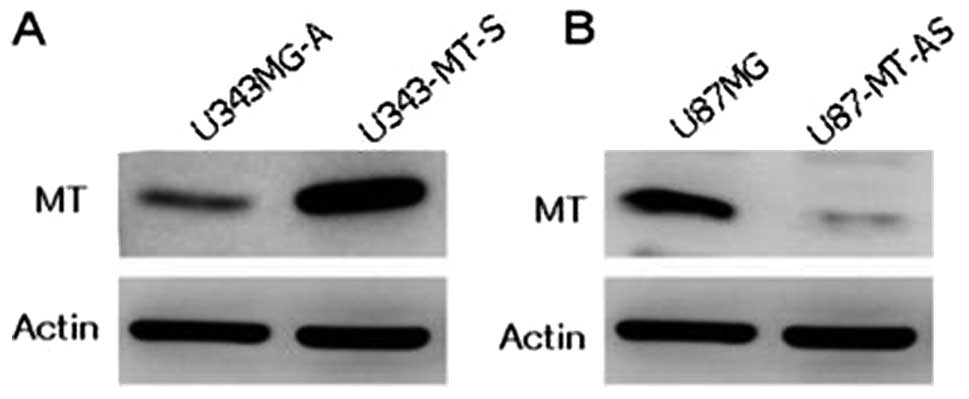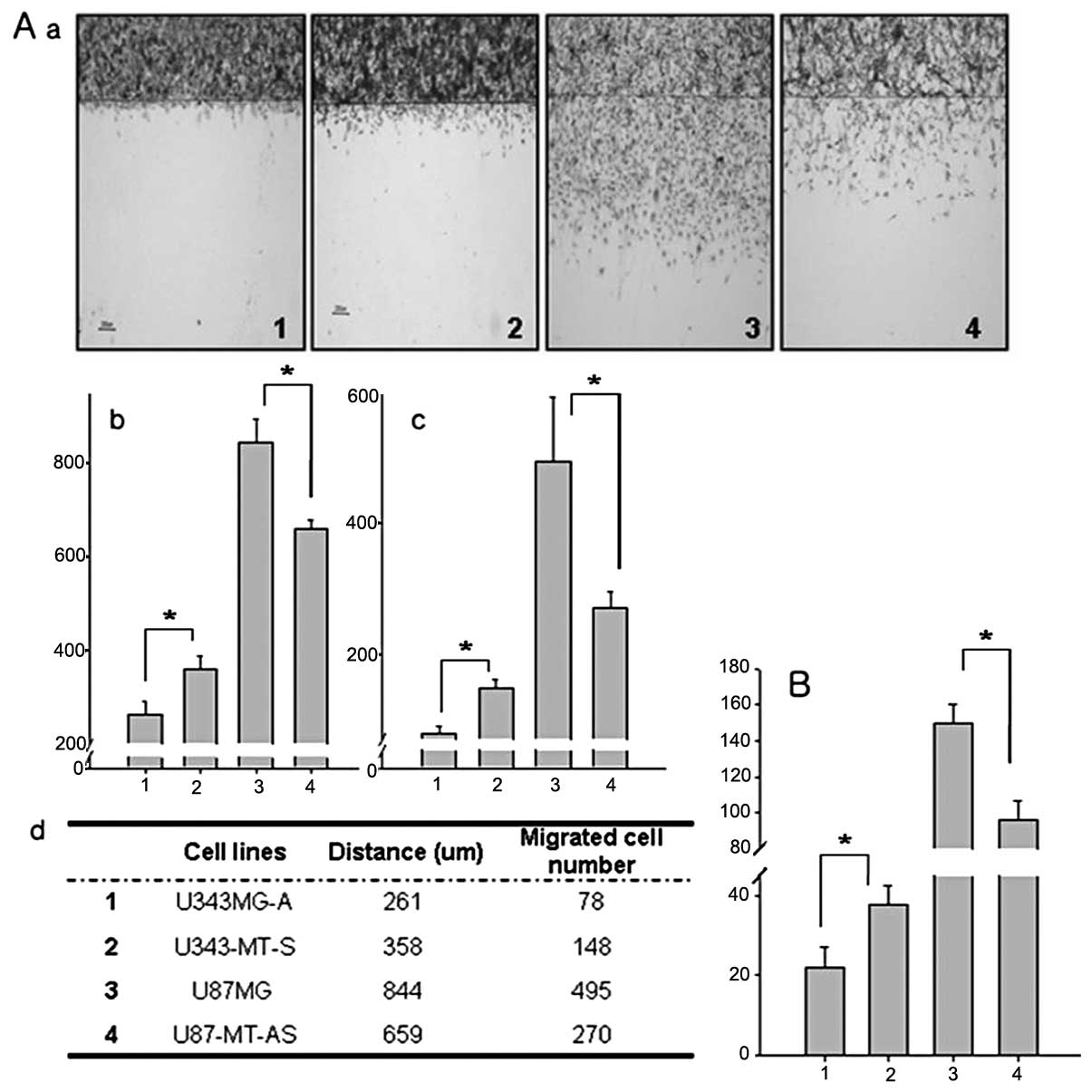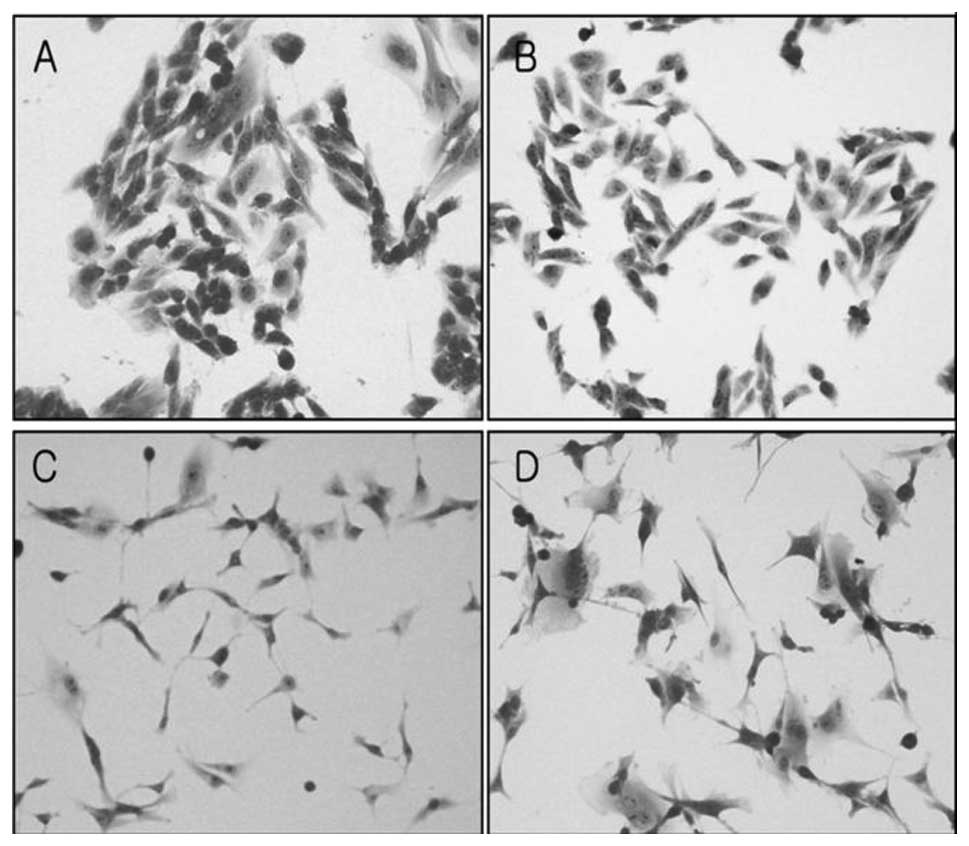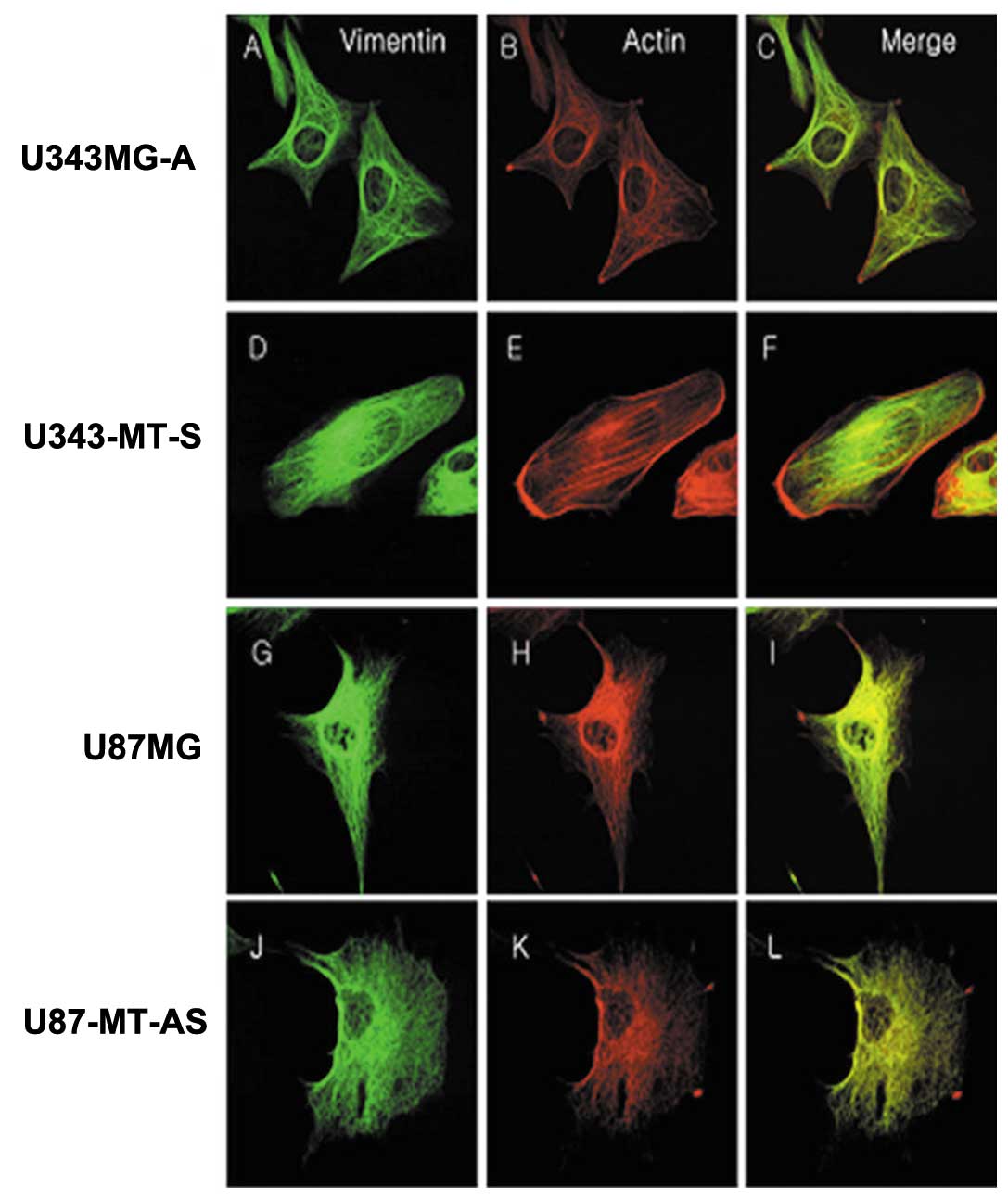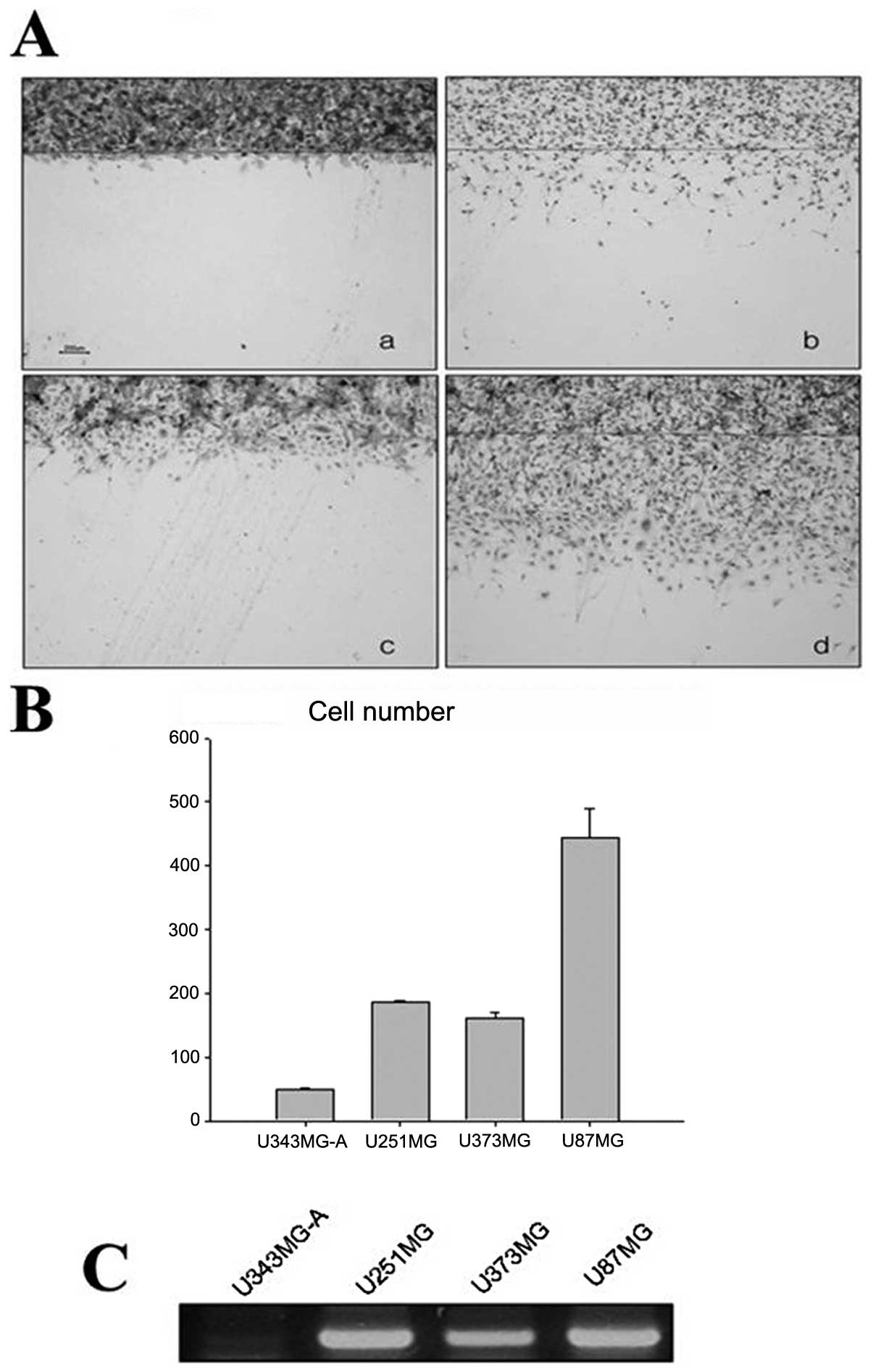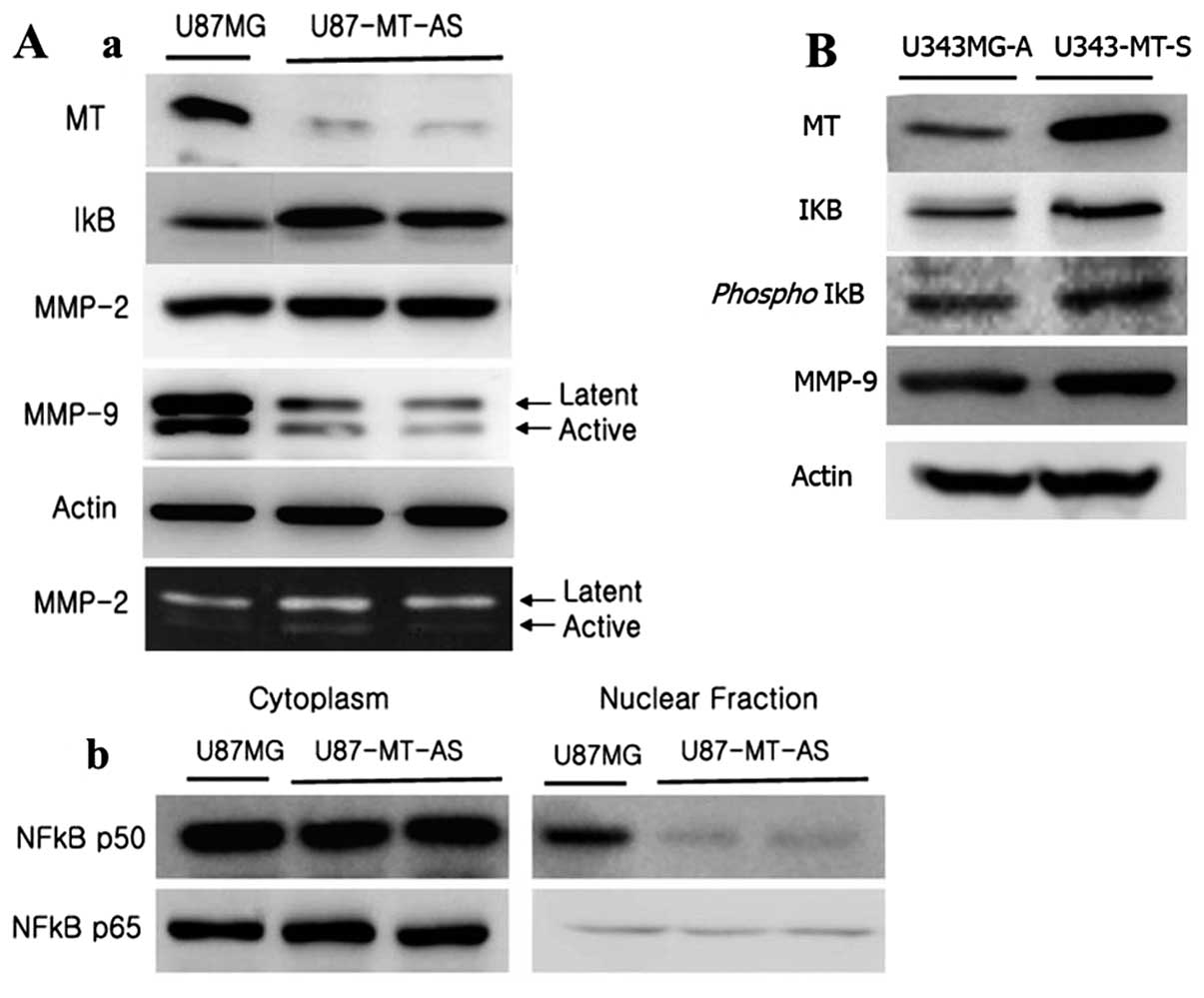Role of metallothionein 1E in the migration and invasion of human glioma cell lines
- Authors:
- Published online on: July 24, 2012 https://doi.org/10.3892/ijo.2012.1570
- Pages: 1305-1313
Abstract
Introduction
The failure of surgical treatment in patients with glioma is mainly due to the invasion of tumor cells into the normal brain beyond the resection areas. These invasive remaining cells are inoperable, resistant to radio- and chemotherapy, and eventually lead to tumor regrowth. Finally, due to the invasion ability of malignant glioma, patients generally die within 1 year after the initial diagnosis (1,2).
To infiltrate into adjacent tissues, certain tumor cells should be able to recognize the barrier matrix, to breach the matrix and to grow into the ectopic locale. Other tumor cells also need to control signaling pathways that would contribute to tumor invasion. It is difficult to directly investigate the specific phenotype that is associated with invasion ability in vivo. The dysregulation of the induced motility of tumor cells has been postulated to be one of the invasion processes that functions in the transmigration of the barrier matrix. Thus, there is a good correlation between increased invasiveness in vivo and increased motility in vitro (1,3,4). The identification of genes related to increased motility is critical for understanding the molecular basis of biological behavior in invasive gliomas.
In a previous study, the authors sought to identify genes that could serve as determining factors for the mobility of malignant glioma cells using DD-PCR (5,6). The results showed that metallothionein 1E was highly expressed in motile cell lines.
Metallothionein 1E (MT1E) is the name for a family of low-molecular weight intracellular metalloproteins with a high affinity for heavy metal ions, such as zinc, cadmium, copper, mercury, and platinum. A striking feature of these metalloproteins is that they are involved in heavy metal detoxification, chemoresistance to anti-cancer drugs and free radical scavenging for cell protection (7–11). Furthermore, they can modulate the activities of zinc-dependent regulatory proteins including enzymes and zinc-finger transcription factors, by the removal and transfer of zinc (12,13). It is also well known that MT participates in fundamental cellular processes, such as cell proliferation and apoptosis (14,15). However, even though many reports have been issued concerning MT, its functions associated with the migration and invasion have not reported in glioma.
Nuclear factor κB (NF-κB) is a transcription factor that regulates an exceptionally large number of genes, particularly those involved in immune and inflammatory responses. NF-κB is a dimer most commonly composed of two protein subunits, p50 and p65, and normally remains in an inactive form in the cytoplasm bound to an inhibitory subunit, IκB. Various stimuli activate upstream IκB kinases, which in turn phosphorylate and degrade IκB. The released NF-κB then enters the nucleus and activates the transcription of many different target genes. NF-κB also plays a pivotal role in a diverse array of cellular activities associated with the regulation of cell death, growth, and development (16). NF-κB has far reaching importance in the regulation of cell death as the overexpression of NF-κB renders cancer cells resistant to chemotherapeutic agents (17–19). MT1E may act as a potential intracellular modulator of NF-κB activation by regulating the cellular level and activity of NF-κB (20,21). Despite the obvious importance of understanding the MT1E-NF-κB interaction, little is known about the tentative molecules that coordinate this interaction.
The relationship between tumor cells and host factors have an effect on invasion, thus a greater understanding of these factors could be important in the anti-invasive research. Primary tumor cell invasion of surrounding tissue is the first stage of a metastasis cascade, and many factors, such as matrix metalloproteinases (MMPs), are associated with this stage (22). MMPs belong to a family of zinc-dependent endopeptidases that degrade the extracellular matrix. Especially, MMPs have well known effects on tumor proliferation and metastasis. Therefore, we investigated whether MT actually modulates migration and invasion in human glioma cells by modulating activity of the NF-κB, MMP-2 and -9.
Materials and methods
Cell lines and cell culture
Human glioma cell lines, U87MG, U251MG, U373MG and U343MG-A were obtained from the Korean Cell Line Bank, Seoul, Korea and from the Brain Tumor Research Center, University of California, San Francisco, CA, USA, respectively. U87MG-10′ was obtained by repetition scratch to tenth U87MG. All cell lines were routinely grown in Dulbecco’s modified Eagle’s medium (Gibco-BRL, Gaithersburg, MD, USA) supplemented with 10% fetal bovine serum (Gibco-BRL, Gaithersburg, MD, USA) at 37°C in a humidified 95% air/5% CO2 atmosphere. Samples of astrocytic tumors were obtained from the patients with the surgery performed at Chonnam National University Hospital. The specimens were snap-frozen in liquid nitrogen and stored at −70°C until use.
Migration assay
In order to stop cell proliferation, the media used to culture cells were replaced with medium containing 5 mM hydroxyurea. After 24 h of hydroxyurea treatment, the cultures were scraped with a single-edged razor blade. Cells were washed twice with PBS and placed in medium containing hydroxyurea. After 48 h of incubation, the cells were washed twice with PBS, fixed with absolute alcohol, and stained with 0.1% toluidine blue. Six microscopic fields were evaluated for each wound injury. The number of cells migrating across the wound edge and the maximum distance migrated were determined in each field and averaged for each injury. These experiments were repeated three times.
RNA isolation from glioma cell lines
Total RNA was isolated from the malignant glioma cell lines using TRIzol (Life Technologies, Gaithersburg, MD) according to the manufacturer’s instructions. After isolating the RNA, the RNA pellets were frozen and stored at −80°C until use.
Differentially display-polymerase chain reaction (DD-PCR)
DD-PCR was performed using the Genefishing™ kit (Seegene Incorp., Seoul, Korea) according to the manufacturer’s instructions. For first strand synthesis, 3 μg of the purified total RNA was incubated with 10 μM dT-ACP for 3 min at 80°C, followed by the addition of a buffer containing 4 μl of 5X RT buffer (Promega, Madison, WI, USA), 1 μl of dNTP (2 mM each), 2.5 μl of 25 mM MgCl2, 2 μl of RNase Inhibitor (40 U/μl Promega), and 1 μl of reverse transcriptase (200 U/μl Promega). The reaction volume was 20 μl, and the reaction was allowed to proceed for 90 min at 42°C, and then for 2 min at 90°C. The PCR protocol for second-strand synthesis was one cycle at 94°C for 3 min, followed by 50°C for 3 min, and 72°C for 1 min. After second-strand DNA synthesis was completed, the PCR products were subjected to second-stage PCR amplification, which included 40 cycles of 94°C for 40 sec, 65°C for 40 sec, 72°C for 40 sec, followed by a 5 min final extension step at 72°C. The PCR products were separated on a 1.2% agarose gel and stained with ethidium bromide. The differentially expressed bands were extracted from the gel using a QIAquick Gel extraction kit (Qiagen, Carlsbad, CA, USA), directly cloned into the pGEMR-T Easy vector (Promega) without reamplification of the recovered bands, and sequenced.
Reverse transcription polymerase chain reaction (RT-PCR)
Total RNA was isolated from three cultured glioma cell lines using TRIzol reagent. A total of 1 μg of RNA was reverse transcribed to synthesize the cDNA. Reverse transcription (RT) was followed by polymerase chain reaction (PCR). For the first strand synthesis, 1 μg of the purified total RNA was incubated with oligo (dT) (0.5 μg/μl Promega) for 5 min at 70°C, followed by the addition of buffer containing 4 μl of 5X Reaction buffer (Promega), 1 μl of dNTP (10 mM each), 3.5 μl of 25 mM MgCl2, 2 μl of RNase Inhibitor (40 U/μl Promega), and 1 μl of reverse transcriptase (200 U/μl Promega). The reaction volume was 20 μl, and the reaction was carried out for 90 min at 42°C, and then for 2 min at 90°C. β-actin was used as an internal control. Reactions with varying numbers of polymerase chain reaction (PCR) cycles were run for each transcript.
Northern blot analysis
Northern blot analysis was performed under conventional conditions. Total RNA (20 μg) was separated by electrophoresis on 1.2% agarose formaldehyde gels, then transferred to a nylon membrane overnight and cross linked with UV irradiation. The filters were prehybridized at 65°C for 3 h and then hybridized to a 32P-labeled probe. The probes were prepared from the clones described above by digestion with restriction enzymes, and this was followed by gel electrophoresis. The filters were washed in SSC and then 0.1% SDS for 15 min at 65°C. They were then exposed to X-ray film at −70°C.
Transfection
Preparation of metallothionein 1E construct
The complete coding region of the human MT cDNA was amplified from U87MG cDNA by PCR with synthetic primers. The PCR primers were designed as follows. MT-sense: 5′-CGGGATCCATGGACCCCAACTGCTCTT-3′, 5′-GCTCTAGAGCTCAG GCACAGCAGCTGCACT-3′. MT-anti sense: 5′-GCTCTAG AGCATGGACCCCAACTGCTCTT-3′, 5′-CGGGATCCTCAGGCACAGCAGCTGCACT-3′ The amplified cDNA was sequenced and directly subcloned into the pcDNA3.1(+) vector (Invitrogen, San Diego, CA, USA) between the BamHI and XbaI sites, which is contained with in the CMV promoter and the neomycin resistance gene. The resulting vectors were designated as pcDNA3.1-MT-S, pcDNA3.1-MT-AS.
Transfection
U343MG-A and U87MG were maintained under exponential growth conditions in DMEM supplemented with 10% fetal bovine serum in the absence of antibiotics
The optimal cell density for transfection is normally between 50–80% confluency for adherent cells. pcDNA3.1-MT-S/AS were respectively transfected into human malignant glioma cell lines U343MG-A and U87MG using the GeneJuice™ transfection reagent (Novagen, Madison, WI, USA). Cells in serum-free DMEM were mixed with 15 μg of plasmid DNA and 45 μl of GeneJuice/serum-free media according to the manufacturer’s protocol. After incubation at 37°C (5% CO2) for 5 h, the transfection mixture was replaced with DMEM supplemented with 10% FBS. After 24 h incubation, the medium was replaced with DMEM containing 10% FBS and 500 μg/ml G418. U343MG-A transfected with sense MT1E cDNA plasmid (pcDNA3.1-MT-S) and U87MG transfected with antisense MT1E cDNA plasmid (pcDNA3.1-MT-AS). Each transfectants were designated as U343-MT-S and U87-MT-AS.
Separation of cytoplams and nuclear extract
Cytoplasmic extraction buffer (CEB) consisted of 10 mM HEPES (pH 7.9), 40 mM KCl, 2 mM MgCl2, 10% glycerol and protease inhibitors. After the cells were scraped into CEB, they were transferred into a micro-centrifuge tube, lysed by vortexing a few times and chilled on ice for 15 min. Nuclei were pelleted by centrifugation at 5,000 rpm for 5 min, and the pellets were washed twice with PBS. The supernatant was removed, and the nuclei were lysed in nuclear extraction buffer consisting of 10 mM HEPES (pH 7.9), 500 mM NaCl, 1% Triton X-100, 10% glycerol and protease inhibitors. After centrifugation at 12,000 rpm for 5 min, the supernatants containing the nuclear proteins were stored at 20°C until use.
Preparation of total protein and conditioned media
For the preparation of total protein, cells were lysed in a protein extraction buffer [50 mM Tris (pH 8.0), 5 mM EDTA, 150 mM sodium chloride, 0.5% deoxycholic acid, 0.1% SDS, 1% NP-40, 1 mM PMSF, and 1 mg/ml protease inhibitor cocktail].
For the preparation of conditioned media, cells were grown in 60-mm plates until they were subconfluent, and were then washed three times with ice-cold CMF-PBS. 1 ml of serum-free medium was added to each plate, and the cells were incubated at 37°C for 48 h. The conditioned media were clarified by centrifugation. The concentrations of all kinds of protein samples were determined using the Bio-Rad protein assay kit (Bio-Rad, Hercules, CA, USA).
Western blotting
A total of 20 μg of whole cell lysates were separated by 15% SDS-PAGE and transferred to a polyvinylidene difluoride membrane (Pall corporation, USA). The membrane was then incubated for 2 h at room temperature in TBS-T solution [10 mM Tris-Cl (pH 8.0), 150 mM NaCl, and 0.05% Tween 20] supplemented with 5% non-fat dry milk and probed overnight at 4°C with anti-metallothionein (Santa Cruz Biotechnology, Santa Cruz, CA, USA), anti-p50, p65 (Cell Signaling Technology, Beverly, MA), anti-MMP2 and MMP9 (BD Pharmingen, San Diego, CA, USA). The bound antibodies were visualized with the appropriate horseradish peroxidaseconjugated secondary antibody (Jackson Immunoresearch Laboratory, WestGrove, PA, USA) conjugated with horseradish peroxidase using enhanced chemiluminescence reagents (ECL, Amersham Biosciences, Bucks, UK).
Cell morphological characteristics
The transfectants and the parental cells were fixed with methanol at 4°C for 10 min. Cells were washed twice with PBS, fixed with cold methanol and stained with 0.1% toluidine blue. These were examined via light microscopy (Nikon, Garden City, NY) and digitally photographed to evaluate and record the morphology of the cell population.
Doubling time of stable transfectants
The cells were seeded at 3×104 cells in 60 mm culture dish. After serum starvation for 24 h, the cells were counted each day. The cells were treated with trypsin-EDTA and the number of viable cells was counted with a hemocytometer. The doubling-time was calculated from the cell growth curve over 5 days. Equation for doubling time = (t-t°)log2/logN-logN° (t, final time; unit, hour; t°, initial times; N, final cell number; N°, initial cell number).
Immunocytochemistry for cytoskeletal proteins
The cells were cultured on glass coverslips in 35 mm dishes until reaching subconfluency, washed with phosphate buffer saline and fixed with 4% p-formaldehyde for 10 min. After washing in immuno/ DNA buffer (Research Genetics, Huntsville, AL, USA), the cells were treated with triton X-100 at 0.1% for 5 min and washed 3–5 more times. The cells were incubated with 2% bovine serum albumin (Sigma-Aldrich, Steinheim, Germany) for 30 min in an effort to reduce non-specific reactions. Incubation with anti-vimentin (BD Pharmingen) was performed in a humid chamber for 1 h, Alexa 488-conjugated goat anti-mouse antibody (Molecular Probe, Eugene, OR, USA) for 40 min. Rhodamineconjugated phalloidin (Molecular Probe) was used for actin staining. The coverslips were mounted on slides with Immuno-mount (Shandon, Pittsburg, PA, USA). Confocal microscopy was performed with a confocal microscope (LaserSharp 2000 version 5.1) equipped with a Plan-Apochromat 63x/1.40 oil objective. Confocal images were acquired using LSM 5102.3 software. The wavelength of each antibody is Alexa 488-Emission 519, Alexa 568-Emission 603 nm.
Invasion assay
Matrigel (reconstituted basement membrane; 25 μg) was dried on a polycarbonated filter (polyvinylpyrrolidone-free; Nucleopore; Whatmann, Madestone, UK). Cells were harvested by brief exposure to 1 mM/l EDTA, washed with DMEM containing 0.1% bovine serum albumin, and added to the Boyden chamber (2x105 cells). Cells were incubated for 24 h at 37°C in a humidified atmosphere of 95% air and 5% CO2. Cells that transversed the Matrigel layer and attached to the filter were stained with the Diff Quik kit (Dade Diagnostics, Aguada, PA, USA) and counted in five randomized fields. The results are expressed as the mean ± SE of three independent experiments.
Data analysis
The comparison of the nucleotide sequence homology of the isolated cDNAs with the registered sequence in Genebank was carried out using the BLAST algorithm. We measured the statistical significance of the cell distance and the cell number using the Mann-Whitney U-test, and the doubling time by repeated measures ANOVA. P<0.05 was considered to be significant. Statistical analysis was performed using the SPSS software program (version 12.0 for Windows; SPSS Inc., Chicago, IL).
Results
Comparison of the migration abilities of three glioma cell lines
The motility of the cell lines was compared using a simple scratch technique. In order to eliminate any confounding effects of an experimental agent on cell proliferation, the cell culture media were replaced with medium containing hydroxyurea. Treatment with hydroxyurea resulted in the complete inhibition of cell proliferation. As shown in Fig. 1, the U87MG cells were more motile than the U343MG-A cells, and the U87MG-10′ cells were the fastest. The difference among the three groups was statistically significant for the mean cell number (p<0.021).
Identification of differentially expressed genes
To obtain a profile of the genes related to invasion, the author estimated the motility of the three cell lines that showed different motilities. MT1E showed a higher expression level in the motile cell lines (Fig. 2A).
Validation of DD-PCR data by RT-PCR and northern blot analysis
The author verified the significant differences in gene expression pattern by RT-PCR and northern blot analysis for the candidate gene. As shown in Fig. 2B and C, there were significant differences in MT expression between the low and high motility cell lines, and the expression patterns matched those of both RT-PCR and northern blot analysis.
Selection of stable transfectants of sense and antisense MT constructs
To assess the effect of MT on proliferation, migration and invasion in malignant glioma cells, the pcDNA 3.1(+) vector containing full length sense and antisense MT1E cDNA was transfected into malignant glioma cell lines under the control of the CMV promoter, and neomycin-resistance transfected clones were obtained. U343MG-A cells expressing low levels of MT1E were inserted into the sense MT1E cDNA construct. In addition, U87MG cells expressing high levels of MT1E were inserted into an antisense MT1E cDNA construct. Western blotting was used to detect the clone that showed the best characterization after transfection with sense and antisense constructs. The U343-MT-S cell line showed a strong band when compared with the parental cell line (Fig. 3A). On the other hand, the U87-MT-AS cell line showed a very faint band when compared with parental cell line (Fig. 3B).
The effect of MT on migration and invasion in malignant glioma cells
Each cell line was pretreated with hydroxyurea, which inhibits cell proliferation, in order to observe changes in cell motility alone. As shown in Fig. 4A, MT1E sense/ antisense-transfected cell lines showed positively altered their motilities. U343MG-A is a less motile cell line. Following sense MT1E transfection, it becomes about 37% faster than parental cell lines. The maximum distance migrated and the mean cell number was 261 μm and 78 cells in the U343MG-A cell line and 358 mm and 148 cells in the U343-MT-S cell line, respectively. The difference between the two groups was statistically significant for the mean cell number (p<0.001) and maximal distance (p<0.001). Likewise, U87MG is a high motility cell line, and it became less motile after transfection with antisense MT. The maximum distance migrated and the mean number of total cells migrated were 844 μm and 495 cells in the U87MG cell line and 659 μm and 270 cells in the M87-MT-AS cell line, respectively. The difference between the two groups was also statistically significant for the mean cell number (p<0.001) and maximal distance (p<0.001). In addition, MT1E on the invasion in the sense and antisense transfectants was markedly enhanced in the Matrigel assay as compared with the parental cell line (p<0.001, Fig. 4B).
Morphological and cytoskeletal changes after MT transfection
Morphological changes were characterized by light microscopy. U343MG-A cells generally formed colonies and were round in shape. On the other hand, U343-MT-S cells grew apart from each other, and their shape became more spindle-like (Fig. 5A and B). In addition, U87-MT-AS cells became flat and enlarged in comparison to U87MG cells (Fig. 5C and D). Immunofluorescence staining of actin and vimentin were performed in order to determine whether the differences in cytoskeletal alterations were associated with tumor cell motility and invasion. The expression patterns of actin and vimentin were similar. The U343-MT-S and U87MG cell lines with high motility formed many stress fibers and showed extensive lamellipodia and strong positive staining in comparison with the parental cell lines. The proteins were distributed on one side around the nucleus and cytoplasm (Fig. 6F and I). On the other hand, the U343MG-A and U87-MT-AS cell lines, which were less motile, showed fewer stress fibers and shorter lamellipodia. The cytoskeletal proteins were mainly concentrated around the nucleus and became entangled (Fig. 6C and L).
Doubling time test
The growth rate was compared of each cell line with those of transfected clones. As shown in Fig. 7, the doubling time was 35 and 31 h in the U343MG-A and U343-MT-S cell lines, respectively. The doubling time for the U87MG and U87-MT-AS cell lines was 32 and 39 h, respectively. U343-MT-S cell line was reduced by about 4 h and that of the U87-MT-AS cell line was only about 7 h, compared with parental cell lines.
Expression of endogenous MT in malignant glioma cell lines
RT-PCR was used to confirm the expression of MT1E in glioma cell lines with different motilities. The U87MG, U251MG, U373MG and U343MG-A cell lines showed high motility sequences (Fig. 8A and B). The levels of MT1E mRNA were proportional to the motility of the cell lines (Fig. 8C).
Effects of MT on NF-κB translocation following the activity of MMP-2 and -9
U87MG cells were stably transfected with antisense MT1E cDNA, and the best two clones were selected (U87-MT-AS). In order to examine the relationship between MT1E and NF-κB activity, the p50 and p65 subunits were detected in the nuclear and cytoplasm fraction by western blot analysis. As shown in Fig. 9A-b, U87-MT-AS showed decreased translocation of the p50 subunit of NF-κB from the cytoplasm to the nucleus when compared with the parental cells. However, the translocation of NF-κB p65 was not particularly changed in comparison with the parental cells. In addition, total IκB was increased in U87-MT-AS (Fig. 9A-a). On the contrary, total IκB was only slightly increased in U343-MT-S. Thus, we checked phospho-IκB expression level in U343-MT-S. As shown in Fig. 9B, the expression of phospho-IκB was increased with total IκB. The expression of MMP-2 in U87MG and U87-MT-AS were detected by western blotting and zymography. But the expression of MMP-9 was only confirmed by western blotting because it could not be detected by zymography. There was no difference in MMP-2 expression between U87MG and U87-MT-AS. However, the active and latent forms of MMP-9 were remarkably decreased in the conditioned media of U87-MT-AS (Fig. 9A-a), otherwise U343-MT-S had increased active forms of MMP-9 in conditioned media.
Discussion
In a previous in vitro study, we identified motility-related genes that would be representative of in vivo invasiveness in glioma cell lines with different motilities using the Genefishing technology (6). Among the identified genes, MT1E was overexpressed in highly motile malignant glioma cell lines, indicating that this gene may be a positive regulator of tumor cell motility. In this study, the author investigated whether MT1E is actually associated with migration and invasion in human glioma cell lines. Firstly, two glioma cell lines were selected with similar origin, but showed a marked difference of their motility (Fig. 4). Then a sense MT1E cDNA construct was transferred into the glioma cell line with less motility, and an antisense MT1E cDNA construct was transferred into glioma cell line with high motility. The effect of MT1E on the migratory and invasive abilities of human glioma cell lines was evaluated by an in vitro assay that involved a simple scratch technique and the Boyden chamber system. The results showed that the proliferation rate in the U343-MT-S cell line, an MT1E-overexpressing cell line, was two times faster, whereas the opposite effect was observed in the U87-MT-AS cell line, which expressed lower levels of MT1E. In addition, some malignant glioma cell lines with different motilities expressed MT in proportion to their mobility. Generally, cell movement is accompanied by various changes, such as morphology, cytoskeleton, and proliferation rate. To determine whether the differences associated with cytoskeletal alterations were also associated with tumor cell motility, immunofluorescence staining for actin and vimentin was performed and the morphological changes in the shape and size of the cells following transfection were examined. The U343-MT-S cells grew apart from each other and showed well-defined stress fibers. On the other hand, when this cell line was transfected with antisense MT1E, the cells became flatter and larger, and the cytoskeletal proteins became entangled. In the process of several experiments, the antisense transfectants was more sensitive to trypsin than the parental cell line (data not shown), while the sense transfectants were resistance to it. This may indicate that these cells are ready to migrate.
MT is related to tumor grade, malignancy and prognosis in certain tumors. MT is correlated with the histological grade and proliferative potential of astrocytic tumors (23,24). In addition, MT is overexpressed in invasive and in situ breast cancer cells, and it may be a biomarker of tumor differentiation and aggressiveness (25,26). In order to verify whether MT1E affects the proliferation of glioma cell lines, doubling time test in U343-MT-S and U87-MT-AS, was performed compared with each parental cell line. Actually, U343-MT-S increased cell proliferation rate, while U87-MT-AS was the opposite. On the basis of the above results, MT-1E may be directly or indirectly involved in cell motility and invasion.
Structural studies of MT have shown that this unusual protein with 61 amino acids (mammalian MT) can bind with both essential metals (zinc and copper) and toxic metals (cadmium and mercury) in two distinct cluster structures in the molecule (27). Due to this characteristic, MTs act as controllers of zinc and copper, by participating in cell proliferation processes (28). MT could donate zinc/copper to various metallo-enzymes and transcription factors (29,30). The protective role of MT in oxidative stress and metal toxicity suggests that MT may also have a functional role in tumor cell survival and growth. According to some reports, MT could facilitate tumor cell growth by two potential mechanisms. One possible mechanism is that MT may act as a zinc donor to various transcription factors, including tumor suppressor gene products, such as p53. In vitro studies have shown that thionein can modulate the transcriptional activation of Sp1, a zinc finger transcription factor. Another possible mechanism is that MT may protect the cells from radiation and chemotherapeutic agents by virtue of its free radical scavenging property (31–33).
We placed major emphasis on first hypothesis, and then desired to look for any factors which have Zn associated site in their structure and associated in tumor cell invasion. It may be related with MT1E in the change of the motility of malignant glioma cell lines.
MMPs are a part of a family of Zn-dependent enzymes and have a well known activity in tumor invasion and metastasis (39). The change of the expression level of MMP-2 and -9 was examined in both total cell lysates and conditioned media in U87MG and U87-MT-AS. The activity of MMP-9 was decreased in U87-MT-AS, while the activity of MMP-2 was similar, in comparison to the parental cell line. In 1996, Haga et al reported that metallothionein increased the activity of MMP, which may change in conformation by chelation with metallothionein (40).
NF-κB is also a zinc-dependent transcription factor, plays a pivotal role in a diverse array of cellular activities and gene activations (30). There are strong pathophysiologic functional similarities between MT and NF-κB. Both are anti-apoptotic entities, especially in cancer cells and both have regulatory roles in inflammation (34,35). Moreover, many stimulators of their expression overlap, including tumor necrosis factor-α, lipopolysaccharide, and interleukin-1 (36). Thus, it is plausible that there is a close molecular relationship between the two molecules. A previous study showed that MT regulates the cellular level and activity of NF-κB as a potential intracellular modulators of NF-κB activation. In addition, MT overexpression was found to up-regulate DNA binding of the NF-κB (21,31,37), and it plays an important role in MMP-9 gene expression (38).
In this study, when MT1E expression was decreased in glioma cell line with high motility, the levels of NF-κB p50 in the nuclear fraction significantly decreased. Most reports on the association between MT and NF-κB have suggested that it involves the p65 subunit of NF-κB. However, the present study showed that MT affected the p50 subunit of NF-κB rather than the p65 subunit. A 1998 report suggested that MT specifically interacts with the p50 subunit of the p50/RelA heterodimer and that MT may be required for the stabilization of its DNA complex formation, thus allowing for the potent transactivation of target genes (39). According to the last report, MT2A promotes breast cancer cell invasion by upregulating MMP-9 via AP-1 and NF-κB (41).
On the basis of our results and reports, MT1E can modulate the motility and invasion in a human glioma cell line. It may involve two mechanisms. MT1E may induce the change of morphology via the modification of cytoskeletal proteins in human glioma cell lines, or MT1E may modulate the activity of MMP-9 by NF-κB in malignant glioma cell lines. This series of events enhances migration and invasion in malignant glioma cell lines. More experiments should be performed to clarify these mechanisms.
Acknowledgements
This research was supported by Leading Foreign Research Institute Recruitment Program through the National Research Foundation of Korea (NRF) funded by the Ministry of Education, Science and Technology (MEST) (2011-0030034).
References
|
Kassis J, Lauffenburger DA, Turner T and Wells A: Tumor invasion as dysregulated cell motility. Semin Cancer Biol. 11:105–117. 2001. View Article : Google Scholar : PubMed/NCBI | |
|
Mariani L, McDonough WS, Hoelzinger DB, Beaudry C, Kaczmarek E, Coons SW, Giese A, Moghaddam M, Seiler RW and Berens ME: Identification and validation of P311 as a glioblastoma invasion gene using laser capture microdissection. Cancer Res. 61:4190–4196. 2001.PubMed/NCBI | |
|
Coffey DS: Prostate cancer metastasis: talking the walk. Nat Med. 2:1305–1306. 1996. View Article : Google Scholar : PubMed/NCBI | |
|
Levine MD, Liotta LA and Stracke ML: Stimulation and regulation of tumor cell motility in invasion and metastasis. EXS. 74:157–179. 1995.PubMed/NCBI | |
|
Kim YJ, Kwak CI, Gu YY, Hwang IT and Chun JY: Annealing control primer system for identification of differentially expressed genes on agarose gels. Biotechniques. 36:424–430. 2004.PubMed/NCBI | |
|
Ryu HH, Jung S, Sun HS, Jung TY, Jin SG, Jin YH, Kim IY, Jeong YI and Kang SS: Screening for motility-associated genes in malignant astrocytoma cell lines. J Neurooncol. 82:125–131. 2007. View Article : Google Scholar : PubMed/NCBI | |
|
Cai L and Cherian MG: Zinc-metallothionein protects from DNA damage induced by radiation better than glutathione and copper- or cadmium-metallothioneins. Toxicol Lett. 136:193–198. 2003. View Article : Google Scholar : PubMed/NCBI | |
|
Ebadi M, Leuschen MP, el Refaey H, Hamada FM and Rojas P: The antioxidant properties of zinc and metallothionein. Neurochem Int. 29:159–166. 1996. View Article : Google Scholar : PubMed/NCBI | |
|
Kelley SL, Basu A, Teicher BA, Hacker MP, Hamer DH and Lazo JS: Overexpression of metallothionein confers resistance to anticancer drugs. Science. 241:1813–1815. 1988. View Article : Google Scholar : PubMed/NCBI | |
|
Roesijadi G: Metal transfer as a mechanism for metallothionein-mediated metal detoxification. Cell Mol Biol (Noisy-le-grand). 46:393–405. 2000.PubMed/NCBI | |
|
Satoh M, Cherian MG, Imura N and Shimizu H: Modulation of resistance to anticancer drugs by inhibition of metallothionein synthesis. Cancer Res. 54:5255–5257. 1994.PubMed/NCBI | |
|
Maret W, Jacob C, Vallee BL and Fischer EH: Inhibitory sites in enzymes: zinc removal and reactivation by thionein. Proc Natl Acad Sci USA. 96:1936–1940. 1999. View Article : Google Scholar : PubMed/NCBI | |
|
Meplan C, Richard MJ and Hainaut P: Metalloregulation of the tumor suppressor protein p53: zinc mediates the renaturation of p53 after exposure to metal chelators in vitro and in intact cells. Oncogene. 19:5227–5236. 2000. View Article : Google Scholar : PubMed/NCBI | |
|
Jayasurya A, Bay BH, Yap WM and Tan NG: Correlation of metallothionein expression with apoptosis in nasopharyngeal carcinoma. Br J Cancer. 82:1198–1203. 2000.PubMed/NCBI | |
|
Nagel WW and Vallee BL: Cell cycle regulation of metallothionein in human colonic cancer cells. Proc Natl Acad Sci USA. 92:579–583. 1995. View Article : Google Scholar : PubMed/NCBI | |
|
Ghosh S, May MJ and Kopp EB: NF-kappa B and Rel proteins: evolutionarily conserved mediators of immune responses. Annu Rev Immunol. 16:225–260. 1998. View Article : Google Scholar : PubMed/NCBI | |
|
Andela VB, Gordon AH, Zotalis G, Rosier RN, Goater JJ, Lewis GD, Schwarz EM, Puzas JE and O’Keefe RJ: NFkappaB: a pivotal transcription factor in prostate cancer metastasis to bone. Clin Orthop Relat Res. S75–S85. 2003. View Article : Google Scholar : PubMed/NCBI | |
|
Baldwin AS: Control of oncogenesis and cancer therapy resistance by the transcription factor NF-kappaB. J Clin Invest. 107:241–246. 2001. View Article : Google Scholar : PubMed/NCBI | |
|
Karin M, Cao Y, Greten FR and Li ZW: NF-kappaB in cancer: from innocent bystander to major culprit. Nat Rev Cancer. 2:301–310. 2002. View Article : Google Scholar : PubMed/NCBI | |
|
Butcher HL, Kennette WA, Collins O, Zalups RK and Koropatnick J: Metallothionein mediates the level and activity of nuclear factor kappa B in murine fibroblasts. J Pharmacol Exp Ther. 310:589–598. 2004. View Article : Google Scholar : PubMed/NCBI | |
|
Kim CH, Kim JH, Lee J and Ahn YS: Zinc-induced NF-kappaB inhibition can be modulated by changes in the intracellular metallothionein level. Toxicol Appl Pharmacol. 190:189–196. 2003. View Article : Google Scholar : PubMed/NCBI | |
|
Nakajima M and Chop AM: Tumor invasion and extracellular matrix degradative enzymes: regulation of activity by organ factors. Semin Cancer Biol. 2:115–127. 1991.PubMed/NCBI | |
|
Hiura T, Khalid H, Yamashita H, Tokunaga Y, Yasunaga A and Shibata S: Immunohistochemical analysis of metallothionein in astrocytic tumors in relation to tumor grade, proliferative potential, and survival. Cancer. 83:2361–2369. 1998. View Article : Google Scholar : PubMed/NCBI | |
|
Maier H, Jones C, Jasani B, Ofner D, Zelger B, Schmid KW and Budka H: Metallothionein overexpression in human brain tumours. Acta Neuropathol. 94:599–604. 1997. View Article : Google Scholar : PubMed/NCBI | |
|
Gallicchio LM, Flaws JA, Fowler BA and Ioffe OB: Metallothionein expression in invasive and in situ breast carcinomas. Cancer Detect Prev. 29:332–337. 2005. View Article : Google Scholar : PubMed/NCBI | |
|
Jin R, Bay BH, Chow VT and Tan PH: Metallothionein 1F mRNA expression correlates with histological grade in breast carcinoma. Breast Cancer Res Treat. 66:265–272. 2001. View Article : Google Scholar : PubMed/NCBI | |
|
Winge DR: Limited proteolysis of metallothioneins. Methods Enzymol. 205:438–447. 1991. View Article : Google Scholar : PubMed/NCBI | |
|
Florianczyk B: Copper and metallothioneins in cancer cells. Ann Univ Mariae Curie Sklodowska Med. 58:390–393. 2003.PubMed/NCBI | |
|
Nartey NO, Banerjee D and Cherian MG: Immunohistochemical localization of metallothionein in cell nucleus and cytoplasm of fetal human liver and kidney and its changes during development. Pathology. 19:233–238. 1987. View Article : Google Scholar : PubMed/NCBI | |
|
Sato M and Bremner I: Oxygen free radicals and metallothionein. Free Radic Biol Med. 14:325–337. 1993. View Article : Google Scholar : PubMed/NCBI | |
|
Cherian MG, Jayasurya A and Bay BH: Metallothioneins in human tumors and potential roles in carcinogenesis. Mutat Res. 533:201–209. 2003. View Article : Google Scholar : PubMed/NCBI | |
|
Shimoda R, Achanzar WE, Qu W, Nagamine T, Takagi H, Mori M and Waalkes MP: Metallothionein is a potential negative regulator of apoptosis. Toxicol Sci. 73:294–300. 2003. View Article : Google Scholar : PubMed/NCBI | |
|
Zeng J, Vallee BL and Kagi JH: Zinc transfer from transcription factor IIIA fingers to thionein clusters. Proc Natl Acad Sci USA. 88:9984–9988. 1991. View Article : Google Scholar : PubMed/NCBI | |
|
Yamamoto Y and Gaynor RB: Therapeutic potential of inhibition of the NF-kappaB pathway in the treatment of inflammation and cancer. J Clin Invest. 107:135–142. 2001. View Article : Google Scholar : PubMed/NCBI | |
|
Zangger K, Oz G, Haslinger E, Kunert O and Armitage IM: Nitric oxide selectively releases metals from the amino-terminal domain of metallothioneins: potential role at inflammatory sites. FASEB J. 15:1303–1305. 2001.PubMed/NCBI | |
|
Coyle P, Philcox JC, Carey LC and Rofe AM: Metallothionein: the multipurpose protein. Cell Mol Life Sci. 59:627–647. 2002. View Article : Google Scholar : PubMed/NCBI | |
|
Kanekiyo M, Itoh N, Kawasaki A, Tanaka J, Nakanishi T and Tanaka K: Zinc-induced activation of the human cytomegalovirus major immediate-early promoter is mediated by metallothionein and nuclear factor-kappaB. Toxicol Appl Pharmacol. 173:146–153. 2001. View Article : Google Scholar : PubMed/NCBI | |
|
Miyamoto H, Altuwaijri S, Cai Y, Messing EM and Chang C: Inhibition of the Akt, cyclooxygenase-2, and matrix metalloproteinase-9 pathways in combination with androgen deprivation therapy: potential therapeutic approaches for prostate cancer. Mol Carcinog. 44:1–10. 2005. View Article : Google Scholar | |
|
Abdel-Mageed AB and Agrawal KC: Activation of nuclear factor kappaB: potential role in metallothionein-mediated mitogenic response. Cancer Res. 58:2335–2338. 1998.PubMed/NCBI | |
|
Haga A, Nagase H, Kito H and Sato T: Enhanced invasiveness of tumour cells after host exposure to heavy metals. Eur J Cancer. 32A:2342–2347. 1996. View Article : Google Scholar : PubMed/NCBI | |
|
Kim HG, Kim JY, Han EH, Hwang YP, Choi JH, Park BH and Jeong HG: Metallothionein-2A overexpression increases the expression of matrix metalloproteinase-9 and invasion of breast caner cells. FEBS Lett. 585:421–428. 2011. View Article : Google Scholar : PubMed/NCBI |



